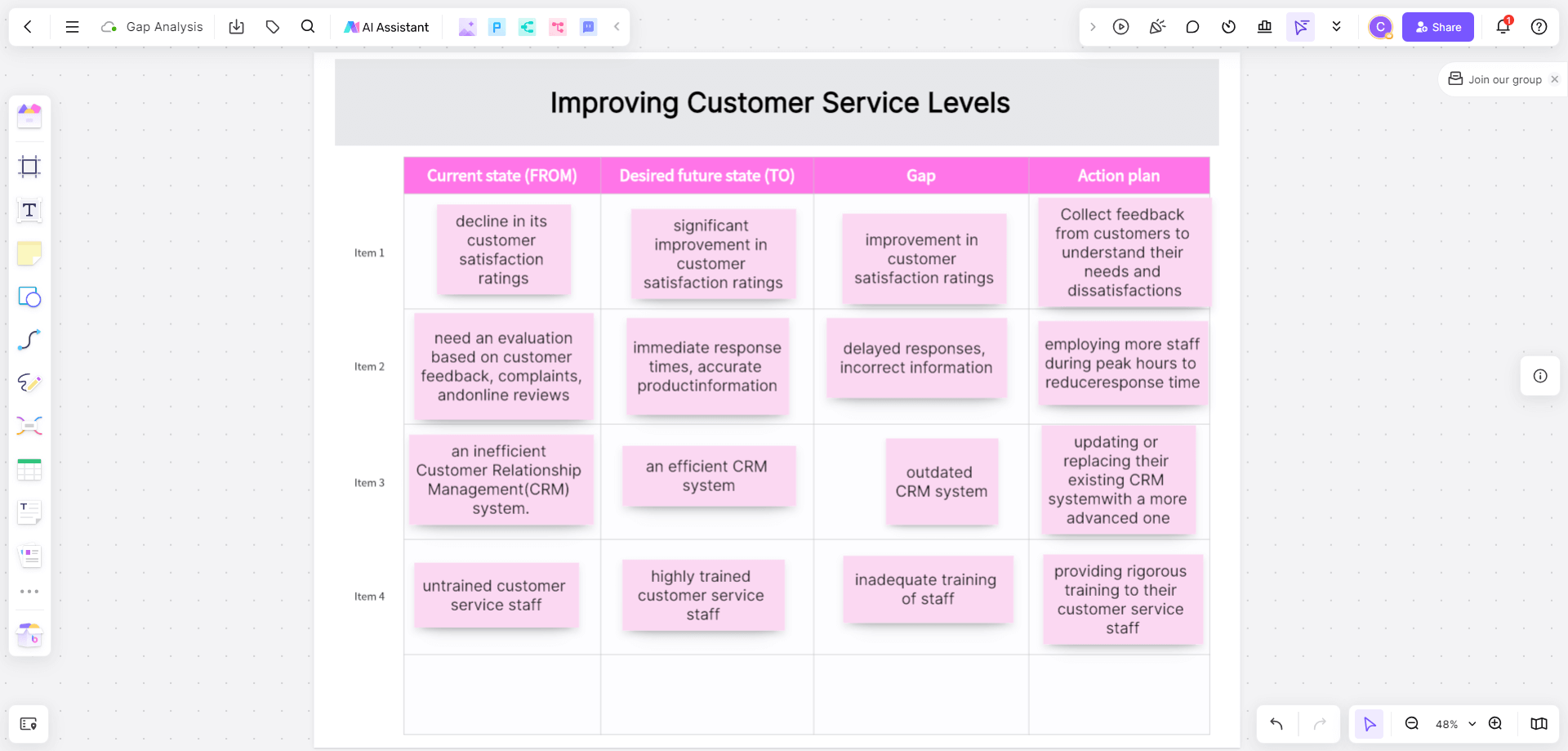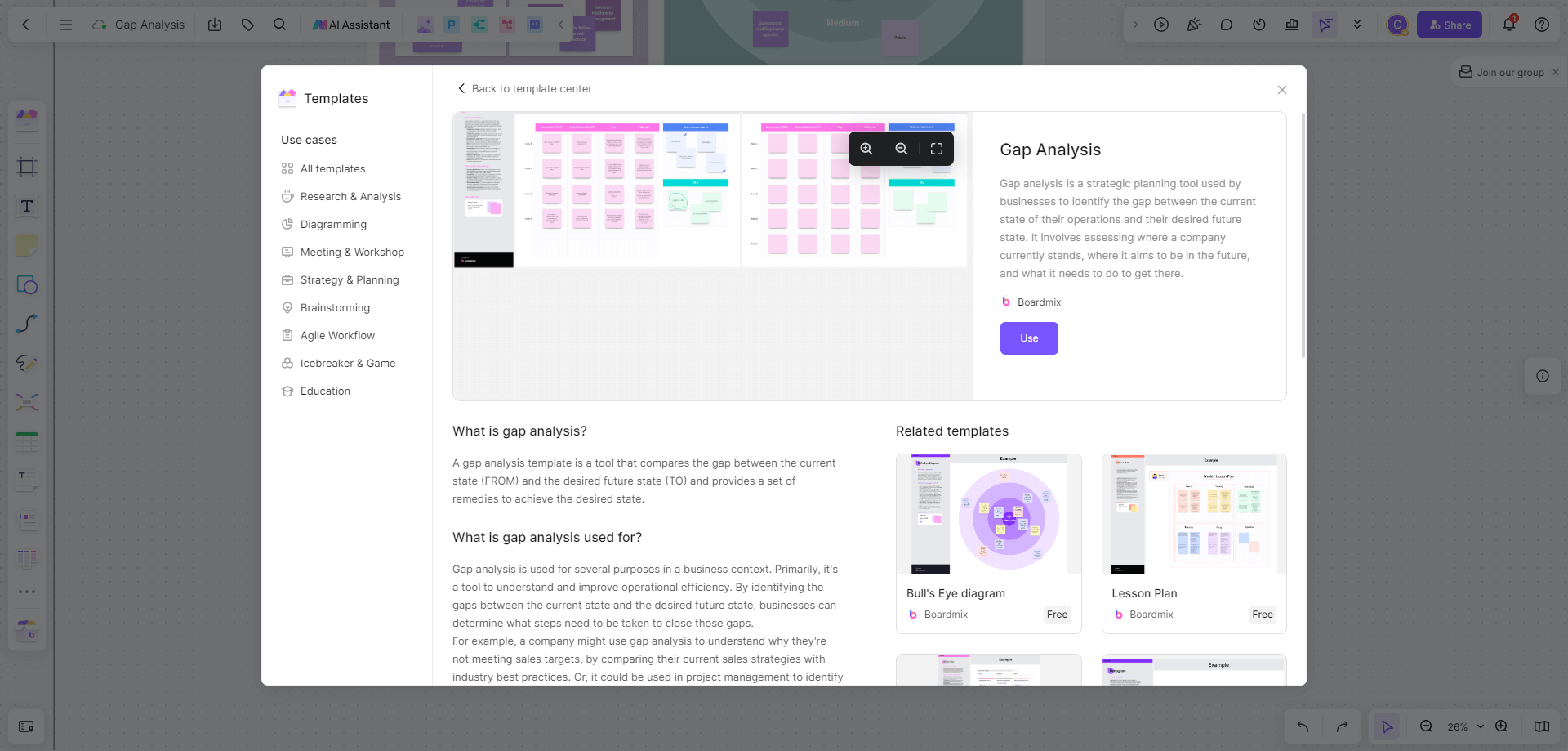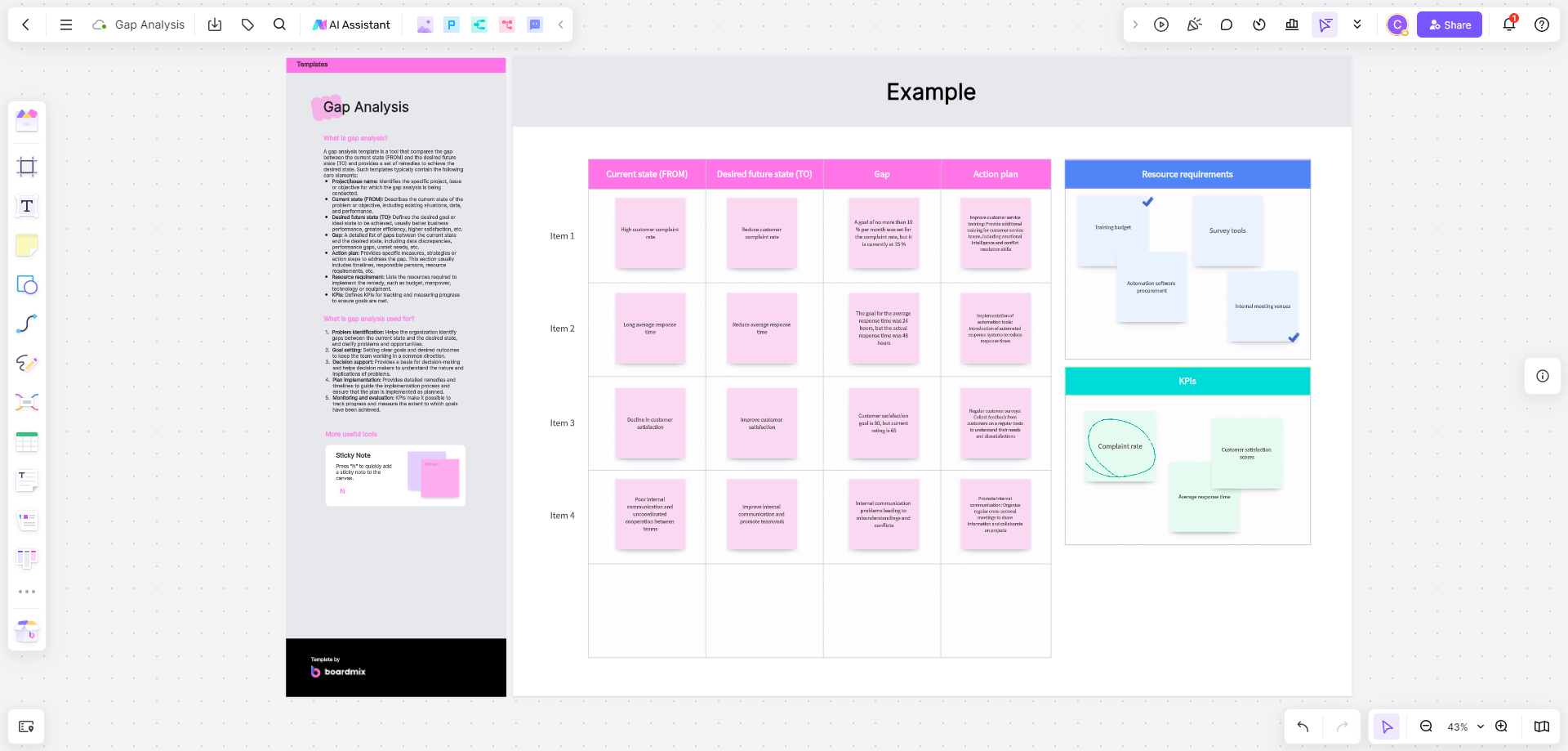The concept of gap analysis extends beyond mere identification. Once gaps are found, strategies and measures are formulated to close or bridge these gaps. The process involves scrutinizing various business aspects such as processes, systems, performance, products, markets, and more.
What is Gap Analysis
Gap analysis is a strategic planning tool used by businesses to identify where they are currently, where they aspire to be, and how to bridge the gap between these two points.
This technique focuses on examining the differences in performance to improve business operations and bring about positive changes. It systematically lists down your company's present situation (current state), desired future condition (target state), and any discrepancies that might exist between the two (the gaps).
The gap analysis process is composed of several core components:

Current State: The first step in gap analysis involves understanding the current state of affairs. It includes an evaluation of the existing business processes, system efficiencies, resources, and outputs.
Desired State: This refers to the goals or objectives an organization aspires to achieve in the future. It could encompass elements like increased revenue, improved product quality, or enhanced customer satisfaction.
Gap Identification: The difference between the current and desired states is the "gap." This could be a performance gap, resource gap, market gap, or any other discrepancy that prevents the organization from achieving its desired state.
Strategies to Bridge the Gap: After identifying the gaps, the next step involves formulating strategies or action plans to bridge these gaps. These plans outline what steps need to be taken to transform the current state into the desired state.
Implementation and Monitoring: Once strategies are formed, they're implemented and consistently monitored to ensure progress towards the desired state.
In a nutshell, gap analysis matrix offers a bird's eye view of where an organization stands and what it needs to do to reach its defined objectives. It serves as a diagnostic tool that identifies opportunities for improvement and propels strategic decision-making.
Why Gap Analysis in Business Strategy Important
In the dynamic business world, strategy development and execution are paramount. Here, gap analysis plays a pivotal role. It's a strategic planning tool that aids businesses in aligning their resources with their goals, acting as a catalyst for growth and prosperity.

By leveraging gap analysis matrix, organizations can gain critical insights into areas that require improvement or adaptation. It's like a compass guiding you in the direction of efficient resource allocation and strategic decision-making. Whether it's refining processes, improving products, enhancing customer satisfaction, or achieving overall business growth, gap analysis can pave the way for real and impactful transformations.
gap analysis is not merely a problem-identification tool; it's the backbone of problem-solving method in business strategy. By defining the current state, identifying the desired state, and outlining the steps to bridge the difference, gap analysis provides a roadmap for action. It brings clarity to complex scenarios, helping decision-makers understand what needs to be changed or improved.
Moreover, gap analysis fosters proactive thinking in businesses. It helps them anticipate future hurdles and take preventive measures before they escalate into significant issues. It also aids in the optimal allocation of resources, prioritizing areas that require immediate attention.
Most importantly, gap analysis matrix helps businesses stay competitive. By continually identifying and addressing gaps, businesses can adapt to market changes, meet customer expectations, and remain at the forefront of their industries. In a nutshell, gap analysis matrix is an essential tool for strategic planning, setting the stage for effective execution and continuous improvement.
Process of Gap Analysis: Step by Step Guide in Boardmix
In an increasingly digital world, businesses are embracing online tools to drive productivity and collaboration. One such tool is the online whiteboard, a versatile platform that can greatly enhance the process of conducting a gap analysis matrix.
Boardmix is a free online whiteboard which is ideal for brainstorming, strategy sessions, diagramming and ideation. With Boardmix’s ready-made template, here's a step-by-step guide on how to conduct a gap analysis using an online whiteboard:

Sign in and Choose the Gap Analysis Template: Open the website and sign in, you can start a new board and choose the gap analysis template.

Define Your Objectives: Start by creating a clear and concise statement of what you aim to achieve with the gap analysis matrix. Use the text feature on your online whiteboard to jot this down, ensuring it's visible for all participants.
Assess Your Current State: Next, evaluate your present situation. Draw up a chart or a table on the online whiteboard outlining the current performance metrics, issues or challenges. Use visual aids like graphs and infographics to represent the data more effectively.
Outline Your Desired State: Clearly define where you want to be in terms of your objectives. Utilize different sections or color codes on your online whiteboard to distinguish between the current state and the desired state.
Identify the Gaps: Now that you have both your current and desired states laid out, identify the gaps or discrepancies that exist. Use arrows or markers to visually link these gaps with the current and desired states.
Devise Action Plans: With your gaps identified, begin formulating strategies or action plans to bridge these gaps. Use a separate section on the board for this step, making sure to list down all necessary actions clearly and systematically.
Execute and Monitor: Implement your action plans while continually using the online whiteboard as a tracking tool. Update progress, add notes or adjust strategies as required in real-time.

Review and Refine: One benefit of using templates in online whiteboard is that you can share your analysis with your team in meetings which is integrated in Boardmix for further discussion of the effectiveness of your strategies regularly. Conduct regular reviews using your digital workspace. Gauge the effectiveness of your strategies, make changes where necessary, and refine your approach.
Using an online whiteboard not only simplifies the gap analysis process but also encourages transparency and collaboration. It allows for real-time updates, fosters team engagement and ensures everyone stays aligned towards the set goals.
Mistakes to Avoid When Performing Gap Analysis
The effectiveness of a gap analysis matrix greatly depends on how meticulously it is conducted. While it can provide invaluable insights when done correctly, it can also lead to misguided decisions if not executed well. Here are some common mistakes businesses should avoid when performing a gap analysis:
Unclear Objectives: A gap analysis matrix must always start with well-defined objectives. Avoid vague, generic goals but try to designate specific numbers and date of each assignment. Without clear and effective OKR management, the process might not yield actionable or measurable results.
Unrealistic Desired State: Your future goals should be ambitious but attainable. Setting unrealistic expectations can lead to disappointment and misdirected efforts.
Poor Communication: Gap analysis matrix is a collaborative process. If your team doesn't understand the objectives or the steps involved, the outcomes can be less than optimal. Make sure the process is well-communicated and everyone involved understands their role.
Neglecting Regular Reviews: Once strategies to bridge gaps are implemented, continuous monitoring is critical. Failing to regularly review the effectiveness of these strategies can hinder progress and diminish results.
Avoiding these mistakes can ensure your gap analysis process is more accurate, reliable, and productive, driving meaningful change and improvements in your business operations.
Conclusion: Improve Performance with Gap Analysis Matrix

Regularly conducting a gap analysis matrix is pivotal for continuous business improvement. It enables organizations to stay abreast with the ever-evolving market dynamics, adapt to changes, and maintain a competitive edge. Meanwhile, the visual interface of an online whiteboard like Boardmix fosters higher team engagement. Complicated data or concepts can be simplified using diagrams or charts, making the process more interactive and comprehensible. This active involvement of team members promotes a sense of ownership, boosting morale and productivity.














